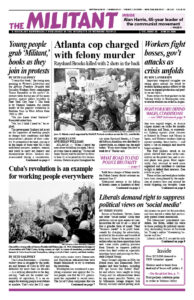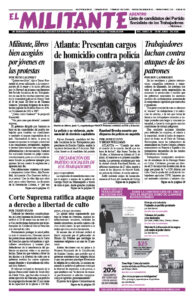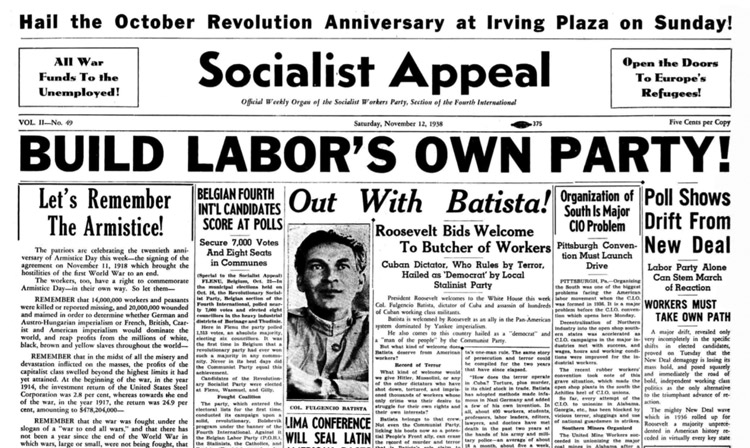The Lesser Evil? Debates on the Democratic Party and Independent Working-Class Politics by Jack Barnes and others is one of Pathfinder’s Books of the Month for June. The excerpt is from a 1965 debate between Barnes, now national secretary of the Socialist Workers Party, and Stanley Aronowitz, who was a leader of Students for a Democratic Society. Barnes explains why workers need to lead all the exploited and oppressed to break from the capitalist rulers’ Democratic and Republican parties and organize their own independent party, a labor party, to fight to take political power. Copyright © 1977 by Pathfinder Press. Reprinted by permission.
BY JACK BARNES
It is only by seeing the character of the 1930s and the big social movement of the 1930s, which was built around the rise of industrial unionism in this country, that you can understand what coalitionism really is today, what it has grown up to be and what role it plays. The first thing to point out is that the building of the CIO was not just the building of a union movement. It was the building of a great social movement that embraced millions of American workers and their families who had never before been active in political life, in any meaningful way, either on the economic, political, or social front. Industrial unionism, which only a few years before had been considered a utopia, embraced millions before the war began. It was the crisis of the 1930s which undoubtedly produced the CIO, that is, it prepared the conditions for the tumultuous development of industrial unionism. The CIO was not a union of the traditional type known in America, that is, a craft union with conservative, special interests. It began and was organized as a broad class movement based on the factory workers.
In fact, it was a semipolitical movement with profound revolutionary implications. If we look at it correctly, we can say that the CIO, from the moment it began to take mass form, was an incipient or potential labor party, political party of labor, in itself. Thus, as millions flocked into the CIO and as millions made up this social movement in the thirties, the central political question in American politics became: Would the workers, who in unprecedented numbers and with unprecedented speed and combativity had organized themselves as a class on the economic front, would they be capable and would they find the leadership to organize politically as a class, to carry out the fight on the political arena; and eventually, within whatever framework this political movement developed, would the workers then develop a program capable of replacing capitalism with socialism, replacing the capitalist parties’ rule with their rule? Not only was this the key question for the workers and for the great social movement in the thirties, it was of course the key question for the capitalists in this country, who, under the leadership of Roosevelt, attempted to adjust, reshape, and reform the institutions of rule in order to absorb the discontent and the upsurge into the traditional political forms.
In 1936, the leaders of the CIO, backed up by the leaders of the Communist Party and many in the Socialist Party, supported Roosevelt. They urged support for the Democratic Party and established for the first time the labor-Negro-liberal Democratic Party coalition. These leaders had no real perspective of independent political action by the workers themselves. …
Before going any further, we might start cleaning up the language about coalitionism, the Democratic Party, labor, et cetera. That is, when you talk about the Democratic Party, or read someone discussing the Democratic Party, as a labor-Negro-liberal coalition — and when you include the great mass of the American workers in it — you are not really talking about a party membership, you are talking about a voting bloc, an electoral weight. That is, the average worker, the average Negro, who once every four years or once every two years pulls the Democratic lever, is a voter, not a party member. …
This is very important, because it brings more sharply into focus the basic idea that a political party’s policy is determined not by who pulls the lever for it every four years. The party is defined and determined by the program it puts forth and by what set of policies and strategies in the world and at home it puts forth, and what class or group within a class these policies serve.
The class the party votes for in its program and policies, not the party that the class votes for, is what determines the kind of party it is. By this criterion the Democratic Party in the 1930s and 1940s was, and remains today, a bourgeois party, a party whose basic program is in the interests of the American ruling class. The electoral coalition forged by Franklin Delano Roosevelt, by the CIO heads, and by the Communist Party, merely guaranteed a solid constituency, to use a term in common usage, at least for a brief period of time.
What we are really talking about when we use the phrase American labor-Negro-liberal coalition is a coalition between the owners of American industry and finance and, on the one hand, the professional ward-heelers and politicians who keep the party machinery oiled, and, on the other hand, the various trade union bureaucrats and leaders of protest movements in American society, whose job it is to bring out the ranks of the coalition at voting time to guarantee the continuance of the rule of this party as opposed to the Republican Party. They are the safety factor, they are the insurance policy, because when the general propaganda fails, when someone starts to step out of line, when the candidates of the party get to be a little too much to stomach, it’s those boys who whip things into shape, who go to the workers, to the Negroes, to the socialists, and say, “Look, it’s in your class interests, it’s in your interests as socialists, to come out and vote for this group, as a tactic” — in order, of course, to defeat the “greater evil.” …
Who really needs this coalition? If you stop to think about it for a moment, it is crystal clear that the small minority who manage to maintain their rule through this coalition — the American capitalist class — are the ones who need the coalition. …
Just as the major task, the central question, of the 1930s was whether the working class would build a political arm, so the major concern, the major task, of the politicians who serve this minority capitalist class today is to prevent the majority class from organizing itself as an independent political force and destroying this coalition.


